Search the Special Collections and Archives Portal
Search Results
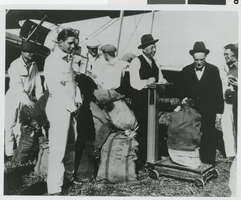
Photograph of first mail flight, Las Vegas, Nevada, 1926
Date
1926
Archival Collection
Description
First mail flight from Los Angeles to Las Vegas. Front left: Maury Graham, pilot; At scales: Harris M. "Pop" Hanshue, founder of Western Air Express, later called Western Airlines. Los Angeles postmaster is weighing mail sacks.
Image
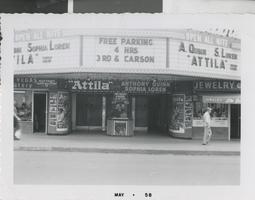
Photograph of the Fremont Theatre marquee advertising "Attila," Las Vegas (Nev.), May 1958
Date
1958-05
Archival Collection
Description
Black and white image of the Fremont Theatre marquee advertising "Attila." The marquee reads: "A. Quinn, S. Loren "Attila" technicolor; Free Parking 4 HRS 3RD & Carson." Another sign reads: "'Attila' starrring Anthony Quinn and Sophia Loren." There are several posters advertising "Attila." Site Name: Fremont Theatre (Las Vegas, Nev.)
Image
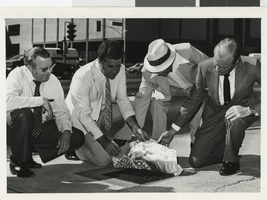
Photograph of John Cahlan and others at Western Airlines plaque, Las Vegas, Nevada, September 23, 1980
Date
1980-09-23
Archival Collection
Description
Unveiling the Western Airlines plaque at the corner of Sahara and Paradise Road, the site of first airport in Las Vegas. L-R: Commissioner P. J. Christensen; Commissioner Ron Lurie; Jubilee coordinator John F. Cahlan; Western Airlines board Chairman Arthur "Art" Kelly.
Image
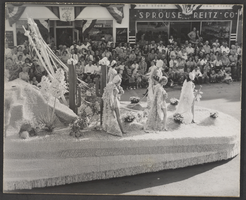
Photograph of a float in the Helldorado Parade on Fremont Street, Las Vegas, Nevada, May 1950
Date
1950-05
Archival Collection
Description
Women in costume stand on a float from Wilbur Clark's Desert Inn, titled "The Old Master Painter." The float was designed by Bill Willard. The women were Donn Arden dancers who had opened at the Desert Inn the month before. The float won 3rd prize in the Helldorado Parade. City Drugs and the Sprouse & Reitz variety store are seen behind the crowd.
Image
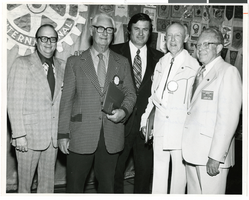
Photograph of Las Vegas Rotary Club members, Las Vegas, Nevada, February 10, 1977
Date
1977-02-10
Archival Collection
Description
Las Vegas Rotary Club members. L-R: Irwin Kishner, Walt Wehrner, Dave Wells, Harvey Luce and Stan Warburton.
Image
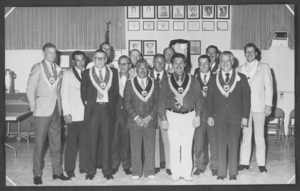
Photograph of North Las Vegas Moose Lodge officers being installed, North Las Vegas, Nevada, circa 1970s
Date
1970 to 1979
Archival Collection
Description
The North Las Vegas Moose Lodge officers being installed, North Las Vegas, Nevada, circa 1970s.
Image
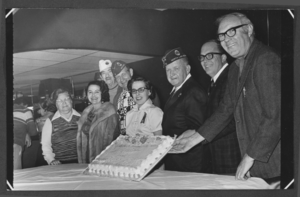
Photograph of North Las Vegas American Legion Post, North Las Vegas, Nevada, March 12, 1974
Date
1974-03-12
Archival Collection
Description
North Las Vegas American Legion Post celebrates, North Las Vegas, Nevada, March 12, 1974. Second from right is Paul May; far right is Gene Echols.
Image
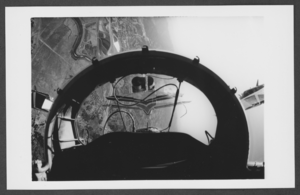
Aerial photograph taken from inside a United States Air Force Thunderbirds plane, circa late 1970s to early 1980s
Date
1977 to 1983
Archival Collection
Description
An aerial view taken from inside a U.S. Air Force Thunderbirds plane, showing other Thunderbirds planes. Photograph possibly taken over Nellis Air Force Base, Nevada.
Image
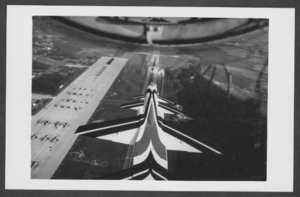
Aerial photograph taken from inside a United States Air Force Thunderbirds plane, circa late 1970s to early 1980s
Date
1977 to 1983
Archival Collection
Description
An aerial view taken from inside a U.S. Air Force Thunderbirds plane, showing another Thunderbirds plane. Photograph probably taken over Nellis Air Force Base, Nevada.
Image

Photograph of Captain Dale Cooke speaking to the press at Nellis Air Force Base, Nevada, January 20, 1982
Date
1982-01-20
Archival Collection
Description
Captain Dale Cooke speaks to the press at Nellis Air Force Base after a fatal U.S. Air Force Thunderbirds crash in Indian Springs, Nevada. Site Name: Nellis Air Force Base (Nev.)
Image
Pagination
Refine my results
Content Type
Creator or Contributor
Subject
Archival Collection
Digital Project
Resource Type
Year
Material Type
Place
Language
Records Classification
